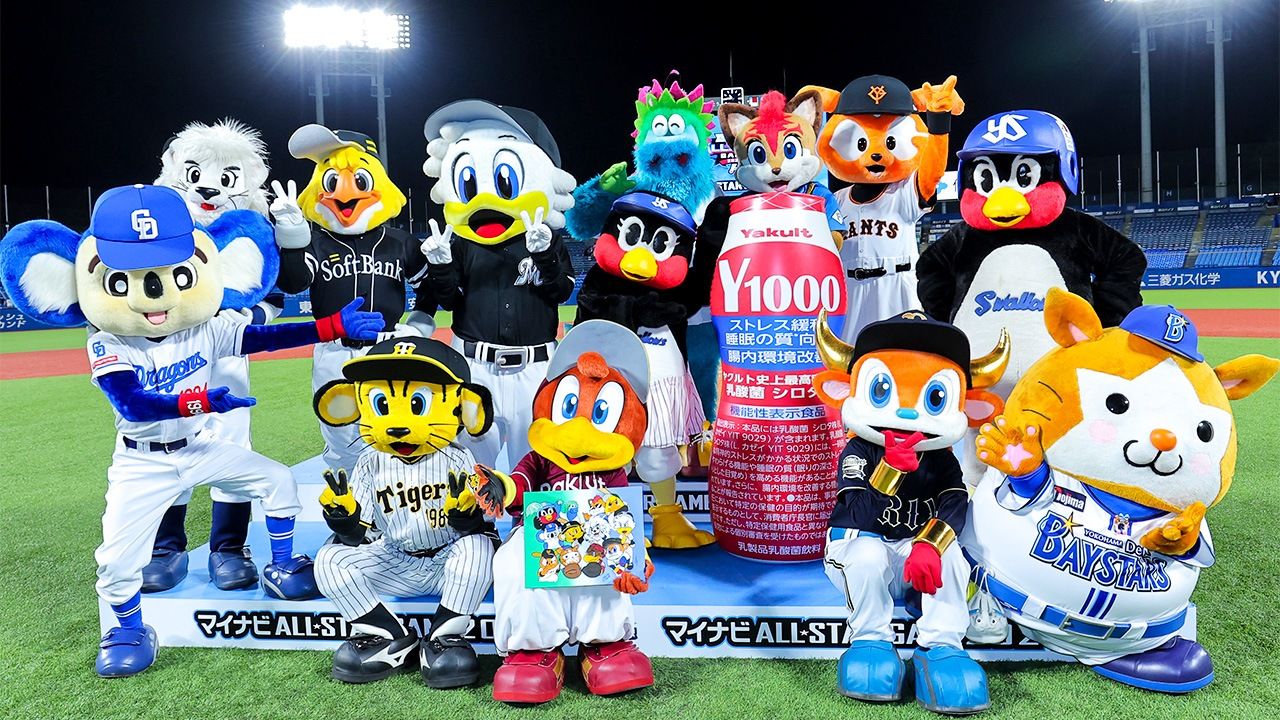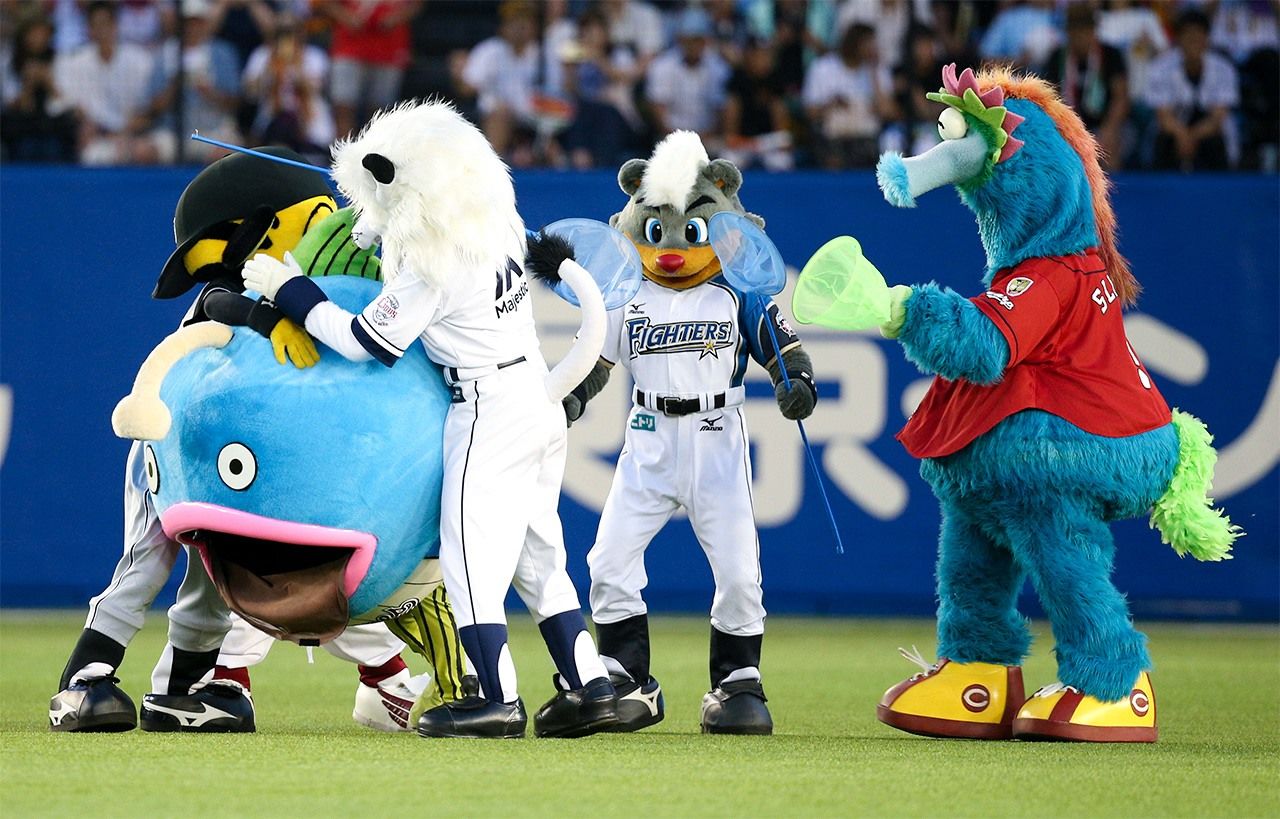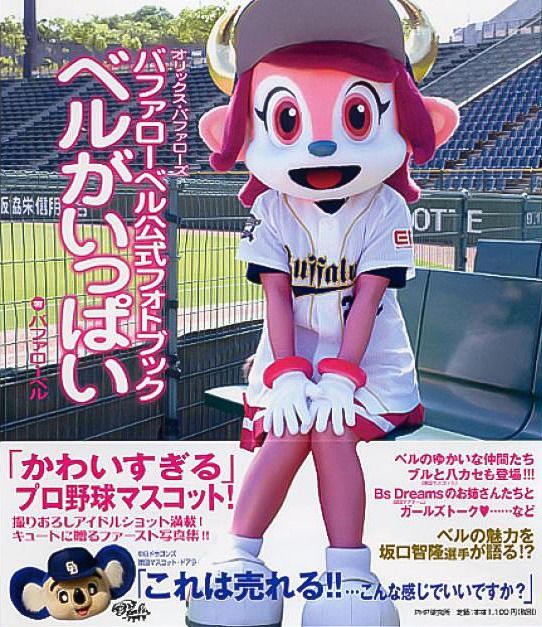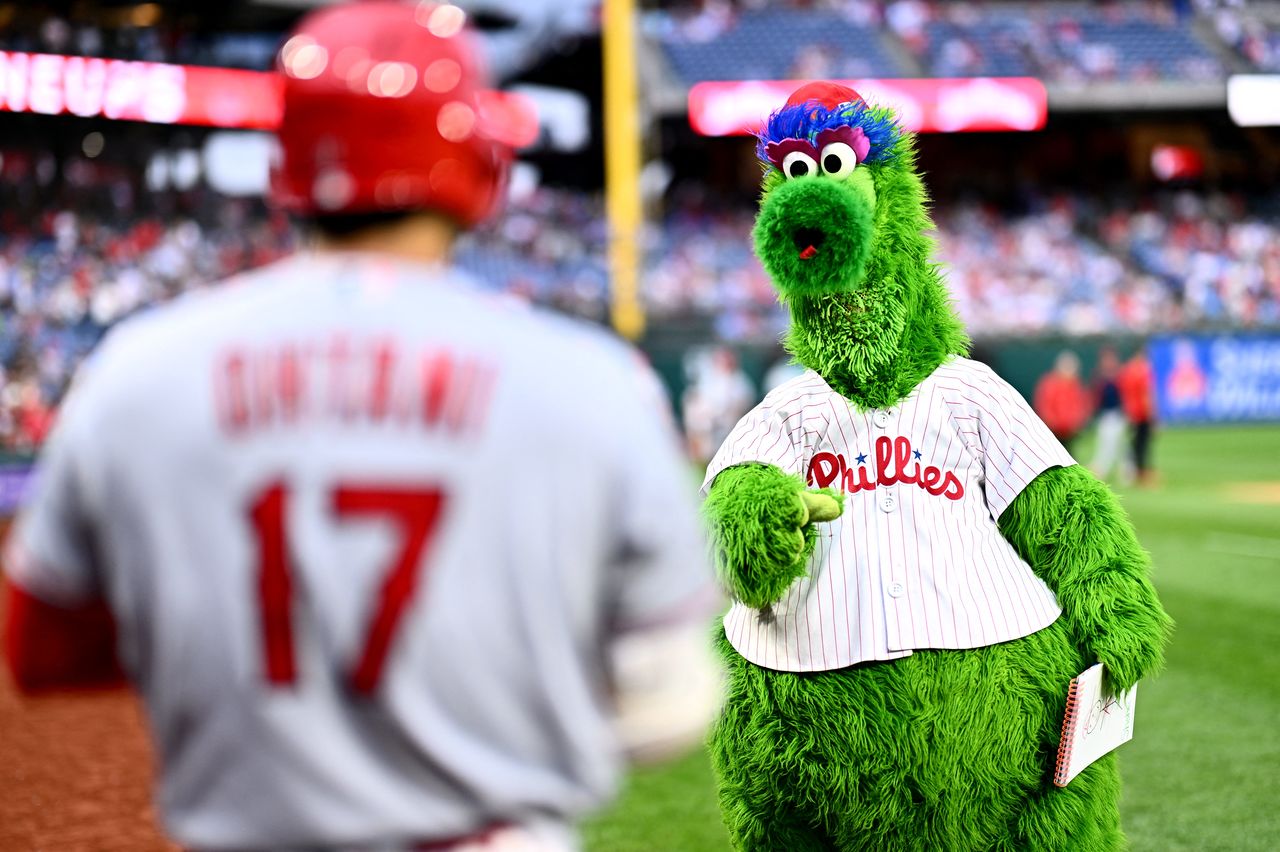
Japan’s Baseball Mascots Overflow with Unique Charm
Culture- English
- 日本語
- 简体字
- 繁體字
- Français
- Español
- العربية
- Русский
Pioneering Mascot Superstars
As Japan moves on into late summer, and the players of Nippon Professional Baseball’s leagues have their eyes on the fall end of the season despite the lingering heat. As they pit their well-honed skills against each other in fierce battles to prove who is best, there are other figures on the field who bring a touch of calming encouragement and thrill the fans at the same time: the mascots. Japan’s teams often have multiple mascots, often with truly unique character.
Among the most original are two who celebrated 30 years of work in 2024: Tsubakurō (at far right in the back of the banner photo) of the Yakult Swallows and Doala (far left) of the Chūnichi Dragons. Neither ever speaks directly with fans, communicating instead by writing messages on large sketchpads. Despite their cute looks, they often display razor sharp tongues—or, rather, pencils—and a rich vein of cynicism in their messages. Their habit of writing out longer messages in clever “flipbook” style sequences has become a baseball staple.
Tsubakurō and Doala consider each other “business partners.” They have reached across team lines to appear together at “lectures,” or dinner shows, events that are so popular that they have become known for selling out of tickets in record-breaking time. Both have also become known beyond baseball fandom by actively courting the general public through frequent TV appearances, posts on their own blogs, and even published books. It’s not at all rare to see social media posts along the lines of, “I don’t know much about baseball, but I love Tsubakurō and Doala.”
Tsubakurō is star of a pregame event at Jingū Stadium games called “Comment of the Day,” where he offers sincere commentary on a popular issue. The topics are not limited to baseball. They often touch on hot button issues like political or entertainment industry scandals, and the flipbook messages combine sharp insight with humor. The messages are all written simply, in hiragana, the way an elementary schooler might, so the contrast between simple style and sharp criticism only adds to the fun.
Apart from 2022, when Murakami Munetaka became the youngest player in history to win Japan’s baseball triple crown by leading the league in home runs, RBIs, and batting average at the same time, Tsubakurō has been the equal of his team’s star players in merchandise sales every year. Fans come to the stadium just to see the mascot, making him a true asset to the club. Even his contract negotiations during the off season have become a thing to watch. Indeed, in the past, those negotiations have fallen through, leading to the mascot announcing his free agency and trying out spots at other teams or companies.
When I interview Tsubakurō, the mood changes often between comedic and serious, and the clever responses to each question drive home just how deeply he values his fans and how much professional pride he has.
Wild and Free in the Best Way
There is no clear record of which club mascot was the first in Japan, but life-sized mascots first hit the diamond in the 1970s. According to the Supōtsu masukotto zukan (Sports Mascot Encyclopedia) by professional baseball design researcher and columnist Tsunashima Ritomo, mascot culture first appeared in the North American Major Leagues in the 1960s. It later spread to Japan under American influence, but eventually Japan’s sports mascots diverged from sports and began to follow their own paths. In other words, a unique character culture was born where the mascots became widely known outside of fan circles, and people with no interest in the game began buying merchandise, accessing their blogs, and more.
We refer to “sports mascots,” but there is a marked difference between the NPB, with its near century of history, and J. League soccer, which only appeared in 1993. J. League was established from the very beginning with a clear, unified concept, namely to “work and move forward as one,” while pro baseball is made up of distinct individual clubs with their own management plans and unique paths. The marked difference in mascots, with pro baseball having far more with unique character, seems to express that different history.
There are certainly orthodox, fiercely tough characters like Seibu’s Leo (based on Tezuka Osamu’s Kimba the White Lion, leftmost at back in the banner photo) and Softbank’s Harry Hawk. At the same time, there are also “weak” characters that get by on charm or cuteness, like the DeNA Baystars’ DB Starman (rightmost at front).
And we must not forget more inexplicable characters, like Nazo no Sakana (The Mystery Fish) that once represented the Lotte Marines. While much about it was revealed—to an almost odd degree, like how it had a family and children, or that its hobby was walking its dog—it remained unclear just what kind of fish it was. Its appearance, at times resembling an angler fish, occasionally changed, and in the end, the character disappeared with the mystery unsolved.
These developments have been wild and free in the best way, and pro baseball mascot culture has flowered into something loved by fans regardless of interest in baseball, or age, or gender.

A gathering of mascots at the 2017 Pro Baseball All Star game. The Hanshin Tigers’s To Lucky (left) and Seibu’s Leo (third from left) are giving Nazo no Sakana (lower left) a walloping. In the center is Nippon Ham’s Brisky the Bear, and rightmost is Hiroshima Carp’s Slyly. Taken on July 15, 2017, at ZozoMarine Stadium. (© Jiji)
Mascots as Local Representatives
Baseball mascots not only fire up crowds and cheer on players, they also carry out a mission of tying baseball to the community and sharing local charm.
For example, take Nippon Ham’s Brisky the Bear. Over a 15-year period starting in 2006 he visited every single municipality in Hokkaidō. He visited sightseeing spots in each area, introduced local produce and cuisine, and interacted with residents as part of a massive community project. He has since passed the torch as main mascot to Frep the Fox (back row, third from right), but off the diamond he is still working to contribute to local communities. His jersey number, 212, was based on the number of Hokkaidō municipalities at the time of his first appearance, and ever since the club moved to Hokkaidō in 2004, he has helped drive the project to make the Fighters a team for the whole prefecture, not just for Sapporo, where the stadium stands.
Hiroshima’s Slyly (back row, fourth from right) marked its twentieth year of service with the publication of a book in 2015, with photos of its visits to places around the prefecture like Miyajima, Onomichi, Sandankyō, and Ōkunoshima, as a bid to spread the word about beautiful local sights.

The Buffalo Bell official photo book Beru ga ippai (Bunches of Bell) is now only available in a digital edition. (Courtesy PHP Institute)
Then there is Buffalo Bell of the Orix Buffaloes, who has become popular as an innocent, pop idol-like character. She first appeared as younger sister to the main mascot Buffalo Bull (front row, second from right), but her adorable looks quickly earned her fans. In 2011, the team published a collection of photos taken at her home stadium, Hotto Motto Field in Kobe. Her name, by the way, was inspired both by the idea of the victory bell, and of the French word belle, for “lovely.”
Influencing America’s Mascots?
Among the many mascots in Japan, there are now many who communicate, like Kumamoto Prefecture’s Kumamon, following on from the pioneering sketchpad writers of pro baseball like Tsubakurō and Doala.
Then there came the time the Phillie Phanatic took out a sketchpad, drew a picture of Ōtani Shōhei, and showed it to him, trying to communicate during an August 2023 game against the Angels. The Phanatic visited Jingū stadium in 2018, where he met Tsubakurō and Doala. Could we be seeing the two flipbook storytelling masters influencing even America’s biggest mascots, now?
If the answer to that is “yes,” it could well prove that Japan’s mascot culture has evolved over the last 50 years into something so unique, it can even change the mascots in baseball’s homeland itself.

The Phillie Phanatic shows Ōtani Shōhei (then with the Los Angeles Angels) a picture it drew, trying to communicate with him before a major league game. Taken on August 29, 2023. at Citizens Bank Park in Philadelphia, Pennsylvania. (© Kyle Ross for USA Today Sports, via Reuters Connect)
(Originally published in Japanese. Banner photo: A commemorative photo of mascots taken after the second game of the 2024 Nippon Professional Baseball All-Star Series with players from the Central and Pacific Leagues. Front row from left: Doala [Chūnichi], To Lucky [Hanshin], Clutch [Rakuten], Buffalo Bull [Orix], and DB Starman [DeNA]. Back row from left: Leo [Seibu], Harry Hawk [Softbank], Mar-kun [Lotte], Tsubami [Yakult], Slyly [Hiroshima], Frep [Nippon Ham], Giabbit [Giants], and Tsubakurō [Yakult]. Taken on July 24, 2024, at Jingū Stadium. © Sankei Shimbun.)
